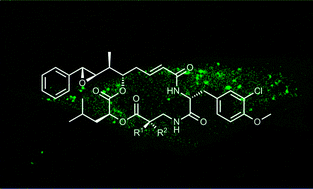Recent approaches for the synthesis of modified cryptophycins†
Abstract
Covering: 2005 to 2013
Cryptophycins are a family of antimitotic depsipeptides with very high cytotoxicity even against multi-drug resistant (MDR) cancer cells. The first representative was isolated from cyanobacteria Nostoc sp. in 1990. Their bioactivity is based on their interaction with the protein tubulin. Cryptophycins were found to induce apoptosis due to inhibition of the microtubule dynamics. Consequently, cryptophycin analogues are considered as potential antitumour agents. Retrosynthetically, cryptophycins can be subdivided into four building blocks, namely units A–D, to be assembled in the total synthesis. Since the discovery of this compound class, numerous synthetic analogues have been designed for structure–activity relationship (SAR) studies. This review gives a critical overview on cryptophycins, while the main focus lies on the synthetic challenges of recently published cryptophycins, together with emerging concepts on cryptophycin bioconjugation and prodrug design.


 Please wait while we load your content...
Please wait while we load your content...